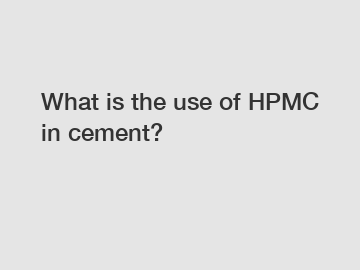What is the use of HPMC in cement?
What is the use of HPMC in cement?
You may have heard about various additives being used in cement to enhance its properties. One such additive is Hydroxypropyl Methylcellulose, commonly referred to as HPMC. But what exactly is the use of HPMC in cement, and how does it affect the final product? In this article, we will explore the benefits and applications of HPMC in cement.
1. Enhancing workability:

One of the primary uses of HPMC in cement is to improve the workability of the mixture. When HPMC is added to cement, it acts as a water retention agent, preventing excessive water evaporation from the mixture. This ensures that the cement remains workable for a longer period, allowing for easier application and better adhesion to different surfaces. The addition of HPMC also reduces the likelihood of cracks forming due to inadequate water retention.
2. Increased bond strength:
Another significant advantage of using HPMC in cement is its ability to improve bond strength. When HPMC is added to the cement mixture, it forms a film over the particles, promoting better interfacial adhesion. This results in stronger bonds between the cement and other materials, such as aggregates or reinforcement. Consequently, the overall structural integrity of the cement composite is enhanced, making it more durable and resistant to external forces.
3. Improved water resistance:
Cement structures are often exposed to water or moisture, which can lead to the deterioration of the material. However, by incorporating HPMC in the cement mix, the final product gains improved water resistance. HPMC forms a protective barrier around the cement particles, reducing water absorption and minimizing the potential for water-related damage. This is particularly beneficial in areas with high humidity or where the cement is likely to be exposed to water for extended periods.
4. Control over setting time:
The setting time of cement plays a crucial role in construction projects, as it determines the working time and the strength development of the material. HPMC can be used as a setting time regulator in cement. By controlling the dosage of HPMC, one can influence the setting time to meet specific project requirements. For instance, in hot weather conditions, a higher dosage of HPMC can help prolong the setting time, allowing more time for proper placement and finishing of the cement.
In conclusion, HPMC has several essential uses in cement that contribute to its improved performance and longevity. It enhances the workability of the mixture, resulting in easier application and reduced cracking. The addition of HPMC improves bond strength, ensuring the durability and integrity of the cement composite. Moreover, HPMC provides better water resistance, protecting the cement structure from moisture-related damage. Lastly, HPMC can be employed to control the setting time of cement, allowing for flexibility and meeting specific project requirements.
Overall, the inclusion of HPMC in cement offers numerous advantages, making it a valuable additive in the construction industry. Whether it's for enhancing workability, improving bond strength, enhancing water resistance, or regulating setting time, HPMC proves to be an essential component in optimizing cement performance.
The company is the world’s best gypsum retarders, gypsum retarders, hpmc manufacturer supplier. We are your one-stop shop for all needs. Our staff are highly-specialized and will help you find the product you need.


